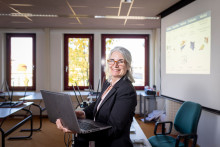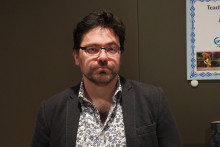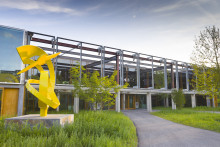Drought and heatwaves may have serious impact on plant health and survival, and as such on the whole ecosystem. Limitations in water availability in combination with excessive heat may impair the healthy functioning of vegetation. In severe cases, these extreme weather events may trigger a situation where extensive vegetation mortality occurs. Scientists have previously revealed that the water content in the leaves and wood (the tissue called ‘xylem’) of trees during droughts are good indicators for the health and proper functioning of vegetation. If a water shortage occurs inside the tree, this impairs a healthy water transport and consequently vital processes, like gas exchange through the leaf stomata and photosynthesis. Without sufficient water inside the plant, the vegetation eventually dies.
Vegetation health
Recent developments in satellite-based remote sensing technology have resulted in the possibility to measure vegetation health, including photosynthesis, from space. Satellites can measure a whole spectrum of light waves reflected from the Earth, including the light re-emitted by vegetation (i.e., fluorescence). According to Zeng, especially fluorescence signals seen by satellites are important. ‘The fluorescence is an optical signal, i.e. light waves, radiating from plants when performing photosynthesis,’ Zeng explains. ‘It can therefore be regarded as an excellent indicator of overall vegetation health.’
'Fluorescence can be regarded as an excellent indicator of overall vegetation health’
Linking the satellite image
The remote sensing images contain a multitude of different light waves measured by the satellites. After interpretation, these eventually give information on vegetation health. This is where models come in the picture. The vegetation photosynthesis model ‘SCOPE’ explains the satellite image and translates it into vegetation and ecosystem health. Team member Christiaan van der Tol, developer of the SCOPE model, explains: ‘By running SCOPE, we copy that satellite image: we tune the relevant variables that are built inside the model, until the SCOPE image matches with the satellite image.’
Important variables that are included in the model are, for example, vegetation color, the amount of water in the leaves, evaporation, and photosynthesis. The model thus gives important information regarding the vegetation: what color is it? Does it contain sufficient water or is it dried out? Is photosynthesis at a healthy rate? ‘Leaf water content is an important variable, since healthy leaves must have a certain range in water content.’ Zeng adds, ‘When this drops below a threshold, the stomata close, and evaporation is reduced, resulting in a drop in photosynthesis as well.’ So, by linking the satellite image with SCOPE, the scientists can monitor the impact of, for example, drought and heat on vegetation health and ultimately, ecosystem functioning.

Soil process model
However, SCOPE only deals with the vegetation part. Crucial soil parameters, like soil properties and moisture content that regulate the water flow from the soil to the roots, are not included. To get a complete picture what is going on with the vegetation during drought and heat, and why, knowledge of what is going on in the soil is a vital component. ‘Soil is the host of plant roots, its properties, like grain size, and moisture content are crucial aspects that also influence vegetation health,’ Zeng explains. ‘They control how much water flows into the tree via roots.’ Not knowing these data makes it very difficult to predict the vegetation response to extreme climatic conditions. To better understand these soil processes, the soil model STEMMUS was developed by Zeng about nine years ago during his PhD with Prof. Bob Su, who has supported its further development since then. This model generates data like, for example, soil water and heat transport inside the soil, evaporation, root water uptake, and leaf water content via soil-root interactions.
Marriage made in heaven
Although the individual models work fine, each model addresses only part of a complex problem and cannot paint the whole picture: vegetation and soil are inseparable and act together. In the newly funded project called EcoExtreML (Accelerating Process Understanding for Ecosystem Functioning under Extreme Climates with Physics-Aware Machine Learning), the researchers will therefore combine both models to get a more complete approach to monitor, understand and predict the response and resilience of vegetation on climate extremes.
‘These models are like a marriage made in heaven’
‘These models are like a marriage made in heaven,’ Zeng says. ‘They complement each other and together they are much more than the sum of both.’ According to project partner Bob Su, the STEMMUS soil model combined with vegetation model SCOPE offers great potential to understand and predict the climate resilience of ecosystems: ‘Together with meteorological data, like temperature, humidity, precipitation, solar radiation, CO2, wind speed, and air pressure, we will be able to propose potential measures to fight against prolonged drought events as we encountered in Europe 2018-2020.’
Virtual laboratory
The combined STEMMUS-SCOPE model can also perfectly serve as the virtual laboratory to study responses of ecosystem functioning to drought and heat extremes. For example, by tuning parameters like soil moisture content in STEMMUS, SCOPE subsequently shows the response of the vegetation and how it looks like in satellite images. Eventually, the refined STEMMUS-SCOPE model will be made publicly available to monitor vegetation health, and provide an early warning tool for crop health locally, regionally and globally. Furthermore, with the rapid development of remote-sensing technologies, the system will also be able to digest satellite data for a large number of other applications. For example, for food security, by quantifying vegetation productivity, forest health, but it can also characterize limiting factors for plant photosynthesis and recovery.







